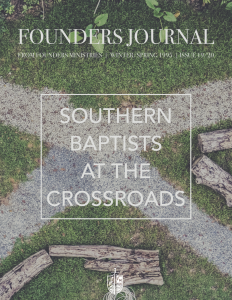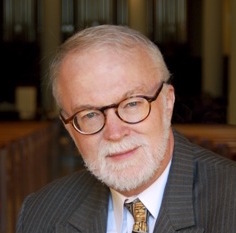Several years ago Will D. Campbell published a fascinating novel entitled The Glad River. The chief character is a man named Doops Momber. Actually his real name was Claudy Momber but everybody called him Doops because Claudy sounded too much like a girl’s name. He grew up among the Baptists of Mississippi, attended the revivals, the hayrides, and the Sunday School wiener roasts, but somehow he never got baptized. Later when he was inducted into the army his sergeant asked, “You a Protestant or a Catholic?” Doops did not answer for a moment. Then he said, “I guess I’m neither. I’m neither Catholic or Protestant. I never joined. But all my people are Baptist.” “But there’s a P on your dog tag. Why not a C?” “They asked me what I was and I told them the same thing I told you. And the guy stamped a P on it.” “Why do you suppose they did that?” the sergeant asked. “Well,” said Doops, “I guess in America you have to be something.”1
The confusion Doops encountered about his own religious identity is symptomatic of many other Baptist Christians who, unlike Doops, have indeed taken the plunge but who, no more than he, have any solid understanding about what that means in a post-denominational age of generic religion and dog-tags Christianity. Several years ago I published an essay entitled “The Renewal of Baptist Theology” which began with the following lamentation:
There is a crisis in Baptist life today which cannot be resolved by bigger budgets, better programs, or more sophisticated systems of data processing and mass communication. It is a crisis of identity rooted in a fundamental theological failure of nerve. The two major diseases of contemporary church are spiritual amnesia (we have forgotten who we are) and ecclesiastical myopia (whoever we are, we are glad we are not like “them”).While these maladies are not unique to the people of God called Baptists, they are perhaps most glaringly present among us.2
This article is a sequel to that earlier essay. First of all, I want to point out some of the difficulties in speaking about the theological identity of Baptists. Then, in the heart of the article, I will present a mosaic for the renewal of Baptist theology by identifying five major components for such an agenda.
Diversity and Adversity
The first problem in sorting out the theological identity of Baptists is the sheer diversity of the movement. From the beginning of the Baptist experiment in seventeenth-century England, General (Arminian) and Particular (Calvinistic) Baptists developed diverse, even mutually incompatible, paradigms for what it meant to be a Baptist. The Particulars, who were better educated, better organized and more successful than the Generals, forged alliances with other mainstream Dissenting bodies denying that they were in any way guilty of “those heterodoxies and fundamental errors” which had been unfairly attributed to them.3 The Generals, on the other hand, were drawn into the orbit of that “swarm of sectaries and schismatics,” as John Taylor put it, which included Levelers, Ranters, Seekers, Quakers, and, at the fag end of the Puritan movement, the mysterious Family of Love. It was, as Christopher Hill has called it, a world turned upside down. An anonymous rhymester may well have had the General Baptists in mind when he penned these lines in 1641: “When women preach and cobblers pray, the fiends in hell make holiday.”4
The diversification of the Baptist tradition which began in England was accelerated in America where the great fact of national life was the frontier-a seemingly endless expanse of space which offered limitless opportunities for escaping the past. “If you and yours don’t agree with me and mine, you can pack your Scofield Bibles in your hip pocket and start your own church!” And so they did. And the line stretches from Roger Williams who left Massachusetts to practice soul-liberty in Rhode Island to Brigham Young who carried the Mormons to Utah to Jim Jones in California and David Koresh in Waco. The frontier was always there.
As for the Baptists, one only has to skim through Mead’s Handbook of Denominations to appreciate the bewildering variety. Among many others, there are American Baptists, Southern Baptists, National Baptists, United Baptists, Conservative Baptists, General Association of Reformation Baptists (GARB), Free Will Baptists, Landmark Baptists, Duck River and Kindred Associations of Baptists, Six Principle Baptists, Primitive Baptists, Seventh Day Baptists, Two-Seed-in-the-Spirit Predestinarian Baptists and the National Baptist Evangelical Life and Soul-Saving Assembly of the USA, Inc.! That’s a lot of Baptists! How do you talk about theological identity amidst that kind of variety?
There’s a second factor we also need to consider-not only diversity within the tradition but adversity from the environing culture. While Baptists in America, especially in the South, have long been accustomed to the accoutrements of an established religion, we began as a small, persecuted sect. Long after the 1689 Act of Toleration granted statutory freedom of worship, Baptists, along with other Nonconformists in England, suffered harassment, discrimination, and ridicule. One critic labeled them as “miscreants begat in rebellion, born in sedition, and nursed in faction.”5 The struggles for religious liberty continued for Baptists in America where Obadiah Holmes was publicly beaten on the streets of Danvers, Massachusetts and John Leland was clapped up in a Virginia jail.
An example of the low esteem in which Baptist folk were held in the early nineteenth century was recorded by David Benedict who traveled by horseback through all the seventeen states of the new nation collecting historical information and impressions about the Baptists. One person, “a very honest and candid old lady,” gave Benedict the following impression she had formed of the Baptists:
There was a company of them in the back part of our town, and an outlandish set of people they certainly were…You could hardly find one among them but what was deformed in some way or other. Some of them were hair-lipped, others were bleary-eyed, or hump-backed, or bow-legged, or clump-footed; hardly any of them looked like other people. But they were all strong for plunging, and let their poor ignorant children run wild, and never had the seal of the covenant put on them.6
Despite diversity within and adversity without, by mid-nineteenth century Baptists in America had developed a remarkable unity of purpose and vision, a theological consensus which even cut across the seismic fault line produced by slavery and the Civil War. Thus Francis Wayland, a Northern Baptist, could write:
I do not believe that any denomination of Christians exists, which, for so long a period as the Baptist, have maintained so invariably the truth of their early confessions…The theological tenets of the Baptists, both in England and America, may be briefly stated as follows: they are emphatically the doctrines of the Reformation, and they have been held with singular unanimity and consistency.7
Thus despite countless splits and some doctrinal defections (e.g. the lapse of certain Baptists into Universalism), there emerged among Baptists in the late nineteenth, early twentieth century America what might be called an orthodox Baptist consensus, represented in the North by Augustus H. Strong, in the South by E. Y. Mullins.
One knew instinctively when the bounds of this consensus had been transgressed. Thus in the controversy surrounding the forced departure of Crawford Howell Toy from Southern Seminary in 1879, both Toy himself and the colleagues who bid him a tearful adieu were all aware, as Toy himself put it, that he “no longer stood where most of his brethren did.”8
Erosion of Theological Consensus
The history of the Baptist movement in the twentieth century could be largely written as the story of the erosion of that theological consensus which obtained in most places until the Fundamentalist-Modernist disputes. In the face of the pressures of this era, the Baptist apologetic made a twofold response, neither of which was really adequate to deal with the challenge at hand. The first response was an appeal to “Baptist distinctives.” In part this effort was fueled by old-fashioned denominational braggadocio, as seen in the book Baptist Why and Why Not published by Baptist Sunday School Board in 1900. Chapter titles include: “Why Baptist and Not Methodist,” “Why Baptist and Not Episcopalian,” “Why Immersion and Not Sprinkling,” “Why Close Communion and Not Open Communion,” etc.9
Further emphasis on Baptist distinctives such as the separation of church and state, the non-sacramental character of the ordinances, and the non-creedal character of our confessions appeared as a litany of negative constraints, rather than the positive exposition of an essential doctrinal core. Indeed, for some Baptists these so-called distinctives, often interpreted in an attenuated, reductionistic form, became the essence of the Baptist tradition itself.
This consensus was further eroded by what may be called the privatization of Baptist theology. Historically Baptist life was shaped by strong communitarian features. The congregation was not merely an aggregate of like-minded individuals, but rather a body of baptized believers gathered in solemn covenant with one another and the Lord. Nor were Baptists doctrinal anarchists who boasted of their “right” to believe in anything they wanted to. Instead of flaunting their Christian freedom in this way, Baptists used it to produce and publish confessions of faith both as a means of declaring their own faith to the world and of guarding the theological integrity of their own fellowship.10 Nor did Baptists want their young children “to think for themselves,” as the liberal cliché has it, but instead to be thoroughly grounded in the faith once for all delivered to the saints. Thus they developed Baptist catechisms and used them in both home and church to instruct their children in the rudiments of Christian theology.
The communitarian character of Baptist life, exemplified by covenants, confessions, and catechisms, was undermined by the privatization of Baptist theology and the rising tide of modern rugged individualism which swept through American culture in the early twentieth century. It should be noted that this movement influenced Baptists at both ends of the religious spectrum. Liberal Baptists followed the theological trajectory of Schleiermacher and Ritschl into revisionist models of theology which denied, in some cases, the most fundamental truths of the gospel.11 At the other extreme, anti-intellectual pietism and emotion-laden revivalism pitted theology against piety, soul religion against a reflective faith, thus producing a schizophrenic split between sound doctrine and holy living. Although Billy Sunday belonged to another denomination, many Baptists could resonate with his assertion that he did not know any more about theology than a jack-rabbit knew about ping-pong!
Thus there developed, not least among Southern Baptists, a kind of theological vacuity, a doctrinal numbness, which resulted in a “form of godliness which denied the power thereof,” an insipid culture religion cut off from the vital wellsprings of the historic Baptist heritage. Denominational pragmatism became the infallible dogma of Southern Baptist life. In the three decades following World War II, Baptist bureaucrats and denominational elites gradually led the SBC toward alignment with mainline Protestant concerns. For example, as amazing as it seems now, the SBC Christian Life Commission during these years was an ardent supporter of the Religious Coalition for Abortion Rights. Without some kind of conservative resurgence, Southern Baptists would doubtless have followed the same path of spiritual decline and theological erosion evident in so many of the mainline denominations.12
It should be stated clearly, however, that the mere replacement of one set of bureaucrats with another doth not a reformation make! The conservative victory in the SBC will prove hollow unless it is accompanied by genuine spiritual and theological renewal. The 150th anniversary of the founding of the SBC is a proper occasion to consider a renewed framework of theological integrity for a world which looks very different from that of 1845 when 293 “delegates,” as they were then called, met in Augusta, Georgia and adopted a plan “for eliciting, combining and directing the energies of the whole denomination in one sacred effort, for the propagation of the gospel.”13
What are the benchmarks for shaping Baptist theological identity for such a time as this? Rather than put forth subtle speculations or a new methodology, I propose that we look again at five classic principles drawn from our own Baptist heritage. These five affirmations form a cluster of convictions which have seen us through turbulent storms in the past. They are worthy anchors for us to cast into the sea of modernity as we seek not merely to weather the storm but to sail with confidence into the future God has prepared for us.
Identity Markers
1. Orthodox Convictions. In 1994 the Southern Baptist Convention unanimously adopted a resolution acknowledging that “Southern Baptists have historically confessed with all true Christians everywhere belief in the Triune God, Father, Son, and Holy Spirit, the full deity and perfect humanity of Jesus Christ, His virgin birth, His sinless life, His substitutionary atonement for sins, His resurrection from the dead, His exaltation to the right hand of God, and His triumphal return; and we recognize that born again believers in the Lord Jesus Christ may be found in all Christian denominations.”
Baptists are orthodox Christians who stand in continuity with the dogmatic consensus of the early church on matters such as the scope of Holy scripture (canon), the doctrine of God (Trinity), and the person and work of Jesus Christ (Christology). Leon McBeth is correct when he observes that Baptists have “often used confessions not to proclaim `Baptist distinctives’ but instead to show how similar Baptists were to other orthodox Christians.”14 Thus the “Orthodox Confession” of 1678 incorporated (article 38) the Apostles’, Nicene, and Athanasian creeds declaring that all three “ought thoroughly to be received, and believed. For we believe, that they may be proved, by most undoubted authority of Holy Scripture and are necessary to be understood of all Christians.”15 Reflecting this same impulse, the Baptists who gathered in London for the inaugural meeting of the Baptist World Alliance in 1905 stood in that assembly and recited in unison the Apostles’ Creed.
Fundamentalism arose in the early part of this century as a protest against the concessions and denials of liberal theologians on such cardinal tenets as the virgin birth of Christ, the inerrancy of the Bible, penal substitutionary atonement, etc. This was a valid and necessary protest and we should be grateful for those worthy forebears who stood with courage and conviction on these matters. However, the problem with fundamentalism as a theological movement was its tendency toward reductionism-not what it affirmed, but what it left out.
In recent years the inspiration and authority of the Bible have again assumed a major role in Baptist polemics. From the drafting of the Baptist Faith and Message in 1963 through the adoption of the Presidential Theological Study Committee Report in 1994, Southern Baptists have repeatedly affirmed their confidence in the inerrancy or total truthfulness of Holy Scripture. As the latter report declares, “What the Bible says, God says; what the Bible says happened, really happened; every miracle, every event, in every book of the Old and New Testaments is altogether true and trustworthy.” In more recent years, however, the SBC has found it necessary to address other pressing doctrinal issues such as the being of God and the importance of using biblical language to address Him (over against contemporary feminism), and our belief in Jesus Christ as sole and sufficient Savior (over against universalism and soteriological pluralism). Southern Baptists need to cultivate a holistic orthodoxy, based on a high view of the Scriptures and congruent with the Trinitarian and Christological consensus of the early church. Only in this way will we avoid the dangers of rigid reductionism on the one hand and liberal revisionism on the other.
2. Evangelical Heritage. Baptists are evangelical Christians who affirm with Martin Luther and John Calvin both the formal and material principles of the Reformation: Scripture alone and justification by faith alone. In setting forth these twin peaks of evangelical faith, the Reformers were not introducing new doctrines or novel ideas. They argued like this: If the doctrine of the Trinity really presents us with the true God of creation and redemption; if Jesus Christ really is what we confess him to be, that is, God from God, Light from Light, very God, from very God; and if original sin is as pervasive and debilitating as we believe it to be, then the doctrine of justification by faith alone is the only faithful interpretation of the New Testament promise of forgiveness, pardon and new life in Christ. While not agreeing with everything Luther or Calvin taught, Baptists claim the heritage of the Reformation as their own. We gladly identify ourselves with other evangelical believers who are “not ashamed of the gospel of Christ for it is the power of God unto salvation for all who believe” (Rom. 1:16).
The word “evangelical” has a myriad of other meanings as well, and Southern Baptists can rightly claim at least two of these. First, we are heirs of the Evangelical Awakening which swept across the eighteenth century producing Pietism in Germany, Methodism in England, and the First Great Awakening in the American colonies. Many features of Baptist life resonate deeply with this mighty moving of the Spirit of God. Our evangelistic witness and missionary vision, our historic emphasis on disciplined church life and godly living, our commitment to a regenerate church membership and Spirit-filled worship, our refusal to divorce the personal and social dimensions of the gospel.
More recently, the word “evangelical” has been associated with the post-fundamentalist resurgence among Bible-believing Christians in North America. Significantly, the two most formative shapers of this movement are both Southern Baptist: Billy Graham and Carl F. H. Henry. While certain moderate Southern Baptists, reflecting an entrenched parochialism, have eschewed the label “evangelical” as a “Yankee word” unworthy for Southern Baptists to wear, more and more Southern Baptists are discovering that they have far more in common with conservative, Bible-believing Christians in other denominations than they do with left-leaning Baptists in their own denomination.16
Far more important than wearing the label “evangelical,” is the substance of the word in the three senses outlined here. Southern Baptists can and should rightly lay claim to the doctrinal legacy of the Reformation, the missionary and evangelistic impulse of the Great Awakening, and a transdenominational fellowship of Bible-believing Christians with whom we share a common commitment to the word of God and the task of world evangelization.
3. Reformed Perspective. Despite a persistent Arminian strain within Baptist life, for much of our history most Baptists adhered faithfully to the doctrines of grace as set forth in Pauline-Augustinian-Reformed theology. David Benedict, following his extensive tour of Baptist churches throughout America in the early nineteenth century, gave the following summary of the Baptist theology he encountered: “Take this denomination at large, I believe the following will be found a pretty correct statement of their views of doctrine. They hold that man in his natural condition is entirely depraved and sinful; but unless he is born again-changed by grace-or made alive unto God-he cannot be fitted for the communion of saints on earth, nor the enjoyment of God in heaven; that where God hath begun a good work, he will carry it on to the end; that there is an election of grace-an effectual calling, etc., and that the happiness of the righteous and the misery of the wicked will both be eternal.”17
When in 1856 James Petigru Boyce set forth his plan for Southern Baptists’ first theological seminary, he warned against the twin errors of Campbellism and Arminianism, the distinctive principles of which “have been engrafted upon many of our churches: and even some of our ministry have not hesitated publicly to avow them.”18
As late as 1905, F. H. Kerfoot, Boyce’s successor as professor of systematic theology at Southern Seminary, could still say, “Nearly all Baptists believe what are usually termed the `doctrines of grace.’”19 E. Y. Mullins, who disliked the label “Calvinist” and “Arminian,” sought to transcend the controversy altogether. While retaining most of the content of traditional Calvinist soteriology, he gave it a new casting by restating it in terms of his distinctive theology of experience.
For some the evangelical Calvinism of earlier Baptist generations has been eclipsed by a truncated hyper-Calvinism with its anti-missionary, anti-evangelistic emphasis. Many other factors have also contributed to the blurring of this part of the Reformation heritage which has shaped Baptist identity: the routinization of revivalism, the growth of pragmatism as a denominational strategy, an attenuated doctrine of the Holy Spirit, and a general theological laxity which has resulted in doctrinal apathy. While seeking to restate traditional themes in fresh contemporary ways, Baptists would do well to connect again with the ideas which inform the theology of such great heroes of the past as John Bunyan, Roger Williams, Andrew Fuller, Adoniram Judson, Luther Rice, and Charles Haddon Spurgeon.
I rejoice in the growing awareness of Reformed theology among Southern Baptists today. I know of nothing that has happened in the history of salvation since the days of James P. Boyce and B. H. Carroll which would make their understanding of God’s grace obsolete in the modern world. To the contrary, a renewed commitment to the sovereignty of God in salvation, worship that centers on the glory of God rather than the entertainment of the audience, and a perspective on history and culture which sees Jesus Christ as Lord of time and eternity, all of this can only result in the building up of the Body of Christ.
At the same time, it is imperative for Reformed Southern Baptists to guard against the real dangers of hyper-Calvinism which emphasizes divine sovereignty to the exclusion of human responsibility and which denies that the offer of the gospel is to be extended to all peoples everywhere. And, as we call on our fellow Baptist brothers and sisters to return to the rock from which we were hewn, we must learn to live in gracious equipoise with some of them who don’t ring all five bells quite the same way we do! In this regard we do well to heed the following statement by the great missionary statesman Luther Rice: “How absurd it is, therefore, to contend against the doctrine of election, or decrees, or divine sovereignty. Let us not, however, become bitter against those who view this matter in a different light, nor treat them in a super serious manner; rather let us be gentle towards all men. For who has made us to differ from what we once were? Who has removed the scales from our eyes?”20
4. Baptist Distinctives. While Baptists owe much to the great doctrinal legacy of the mainline reformers, our ecclesiology most closely approximates the Anabaptist ideal in its emphasis on the church as an intentional community composed of regenerated and baptized believers who are bound to one another and their Lord by a solemn covenant. One of the most important contributions which Baptists have made to the wider life of the church is the recovery of the early church practice of baptism as an adult right of initiation signifying a committed participation in the life, death, and resurrection of Jesus Christ. In many contemporary Baptist settings, however, baptism is in danger of being divorced from the context of the decisive life commitment. This unfortunate development is reflected both in the liturgical placement of baptism in the worship service-often tacked on at the end as a kind of afterthought-and also in the proper age and preparation of baptismal candidates. This situation muffles the historic Baptist protest against infant baptism, a protest which insisted on the intrinsic connection between biblical baptism and repentance and faith.21
We must also guard against a minimalist understanding of the Lord’s Supper which reduces this vital ordinance to an empty ritual detached from the spiritual life of believers. Several years ago I experienced a powerful service of the Lord’s Supper at the First Baptist Church of Dallas, Texas. During a Sunday morning service that great congregation was asked to kneel and prayerfully receive the elements while the meaning of the ordinance was carefully explained from the Scriptures. In this kind of setting the experience of worship is a transforming encounter with the living Christ. We need not fall prey to the lure of sacramentalism or the false doctrine of transubstantiation to reclaim the historic Baptist understanding of the Lord’s Supper which has nowhere been better described than in the Second London Confession of 1689: “Worthy receivers, outwardly partaking of the visible elements in this ordinance, do then also inwardly by faith, really and indeed, yet not carnally and corporally, but spiritually receive, and feed upon Christ crucified and all the benefits of His death: the Body and Blood of Christ, being then not corporally, or carnally, but spiritually present to the faith of believers, in that ordinance, as the elements themselves are to the outward senses.”
5. Confessional Context. On the 150th anniversary of the SBC, we would do well to remember and reclaim the confessional character of our common Christian commitment. Baptists are not a creedal people in that we regard no humanly devised statement as equal to the Bible. Nor do we believe that the state has any authority to impose religious beliefs on its subjects. However, Baptists have historically approved and circulated confessions of faith for a three-fold purpose: as an expression of our religious liberty, as a statement of our theological convictions, and as a witness of the truths we hold in sacred trust. Our confessions are always accountable to Holy Scripture and revisable in the light of that divine revelation.
Just as a confession declares what we believe, so a church covenant is concerned with how we live. It sets forth in practical terms the ideal of the Christian life: a living faith working by love leading to holiness. The congregation’s covenant also outlines that process of mutual admonition and responsibility through which fellow believers engage to “watch over” one another through encouragement, correction, and prayer.
Finally, catechisis is concerned with passing on the faith intact to the rising generation. This responsibility is jointly shared by parents and pastors. May God give us again Baptist families and Baptist churches who will take seriously the awesome responsibility of indoctrinating our children in the things of God.
Conclusion
In his Commentary on Daniel (9:25), John Calvin compared the work of God among his ancient people with the challenge of his own day. “God still wishes in these days to build his spiritual temple amidst the anxieties of the times. The faithful must still hold the trowel in one hand and the sword in the other, because the building of the church must still be combined with many struggles.” That struggle continues today not against enemies of flesh and blood but against principalities and powers, against lethargy and laziness, against defection and darkness on every hand. Yet God does continue to build His church amidst the anxieties of the times. For 150 years he has blessed and used the people of God called Southern Baptists in ways that future historians will record as remarkable beyond belief. As we remember and give thanks for the mighty acts of God in days gone by, let us press forward in the earnest expectation that the Lord “hath yet more truth and light to break forth out of His Holy Word.” Above all, let us never forget that it is “not by might, nor by power, but by my Spirit, saith the Lord.”
1 Will D. Campbell, The Glad River (New York: Holt, Rinehart and Winston, 1982), 107.
2 Timothy George and David S. Dockery, eds., Baptist Theologians (Nashville: Broadman Press, 1990), 13.
3 William L. Lumpkin, ed., Baptist Confessions of Faith (Valley Forge: Judson Press, 1959), 244.
4 Michael Watts, The Dissenters (Oxford: Clarendon Press, 1978), 83.
5 Henry Sacheverell, The Perils of False Brethren (London, 1709), 36.
6 David Benedict, Fifty Years Among the Baptists (New York: Sheldon and Co., 1860), 93-94.
7 Francis Wayland, The Principles and Practices of Baptist Churches (London: J. Heaton and Son, 1861), 15-16.
8 George H. Shiver, ed., American Religious Heretics (Nashville: Abingdon, 1966), 56-88.
9 James M. Frost, Baptist Why and Why Not (Nashville: Sunday School Board, 1900).
10 See the classic statement by James P. Boyce in his “Three Changes in Theological Institutions,” in Timothy George, ed., James Petigru Boyce: Selected Writings (Nashville: Broadman Press, 1989), 48-59.
11 Thus by the end of his life in 1921 A.H. Strong, a moderate throughout his career, had sided with the Fundamentalists in their dispute with Modernism. Lamenting “some common theological trends of our time,” Strong warned: “Under the influence of Ritchl and his Kantian relativism, many of our teachers and preachers have swung off into a practical denial of Christ’s deity and of His atonement. We seem upon the verge of a second Unitarian defection, that will break up churches and compel secessions, in a worse manner than did that of Channing and Ware a century ago. American Christianity recovered from that disaster only by vigorously asserting the authority of Christ and the inspiration of the Scriptures. . . . Without a revival of this faith our churches will become secularized, mission enterprise will die out, and the candlestick will be removed out of its place as it was with the seven churches of Asia, and as it has been with the apostate churches of New England.” Systematic Theology (Valley Forge, PA: Judson Press, 1907), ix.
12 For an analysis of the SBC controversy along these lines, see Timothy George, “Toward an Evangelical Future,” in Southern Baptists Observed: Multiple Perspectives on a Changing Denomination, ed. Nancy T. Ammerman (Knoxville: University of Tennessee Press, 1993), 276-300.
13 Robert A. Baker, ed., A Baptist Source Book (Nashville: Broadman Press, 1966), 116.
14 H. Leon McBeth, The Baptist Heritage (Nashville: Broadman Press, 1987), 68.
15 W. L. Lumpkin, ed., Baptist Confessions of Faith (Valley Forge: Judson Press, 1959), 326.
16 Cf. the reaction of an SBC agency head to the press’ dubbing of Jimmy Carter as a “Southern Baptist evangelical” during the 1976 presidential campaign: “We are not evangelicals. That’s a Yankee word. They want to claim us because we are big and successful and growing every year. But we have our own traditions, our own hymns and more students in our seminaries than they have in all of theirs put together.” Quote in Kenneth L. Woodward et.al. “Born Again! The Year of the Evangelicals,” Newsweek (October 25, 1976), 76. Early on in the SBC controversy, two Baptist historians, E. Glenn Hinson and James Leo Garrett, Jr. engaged in a scholarly debate over the question, “Are Southern Baptists Evangelicals?” Garrett, who answered in the affirmative, presented a much more credible historical analysis than Hinson. It is only fair to admit, however, that Hinson did represent a libertarian subculture within Southern Baptist life whose forebears would not want to be classified as evangelicals. See James Leo Garrett, Jr., E. Glenn Hinson, James E. Tull, Are Southern Baptists “Evangelicals”? (Macon: Mercer University Press, 1983).
17 David Benedict, A General History of the Baptist Denomination in America (Boston: Lincoln and Edmands, 1813) 2:456.
18 George, ed., Boyce, 33.
19 Quoted, Thomas J. Nettles, By His Grace and For His Glory (Grand Rapids: Baker, 1986), 50.
20 James B. Taylor, Memoir of Rev. Luther Rice, One of the First American Missionaries to the East (Baltimore: Armstrong and Berry, 1840), 332-333.
21 See Timothy George, “The Reformed Doctrine of Believer’s Baptism,” Interpretation 47 (1993), 242-254.























